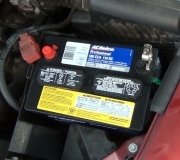Dandy. I have two comments of value to start with. The first is if the alternator was removed for testing, that is not an effective way to do it. That does not include the rest of the system in the test. Second, regardless if it was tested on or off the engine, it has to be done while the problem is occurring. You have already observed the problem acts up intermittently, and I am pretty sure the testing was done while it was working.
By far the most common cause of intermittent loss of charging is worn brushes inside the alternator. Trucks are one of the few models where the alternator has to be removed to replace the assembly. I can do this on my Grand Caravans while the alternator is still bolted in place. The brush assembly costs around $10.00 to $12.00 but you might not find it at an auto parts store. The dealer's parts department will have them, or look for a starter/generator rebuilding company. All larger cities have at least one.
To verify if I am right, look on the back of the alternator and you will see two small wires going into a black plastic block. There is a larger wire too, but we are not interested in that one for now. Those two small wires come out on two very small terminals with two just-as-small nuts. They are side-by-side, as I recall, about 3/4" apart. Those are the two test points you need to take voltage readings on. That block has another tab that is just for bolting it in place. That is not part of this story.
The engine has to be running for these tests. With the engine not running, supply voltage is turned off and any readings will be meaningless. You should find twelve volts on one of those two terminals. What is important is what you find on the other one. In the rare event you find exactly the same voltage on both test points, there is a break in the control wire going to the voltage regulator inside the engine computer. While not unheard of, that is not real common. These nuts often become real rusty. That rust makes it hard to get a good reading. You might have to sharpen the test probes or push on them fairly hard.
Normal operation is when you find less than full battery voltage on the second terminal, but not 0 volts. Typically you will find from 4 - 11 volts. The lower this voltage, the larger the difference, which means the stronger the electromagnetic field is being developed and the harder the alternator is working.
The last possibility is you find 0 volts on that second terminal. Only two things can cause that, but they would have different symptoms. The control wire going to the voltage regulator could be shorted to ground. That would cause severe over-charging and real high system voltage. That is not what you have. The other possibility is the worn brushes I described already.
To sum this up, if you find full battery voltage on one terminal, and 0 volts on the other, replace the alternator or its brush assembly.
Regardless how you repair this, you are going to have to disconnect the battery's negative cable while you work in this area. When you reconnect it and try to start the engine, idle speed will be too low, possibly to the point the engine will not even start unless you hold the accelerator pedal down 1/4". It will tend to stall at stop signs too. To solve that, drive at highway speed with the engine warmed up, then coast for at least seven seconds without touching the pedals.
Saturday, December 30th, 2017 AT 10:02 PM

